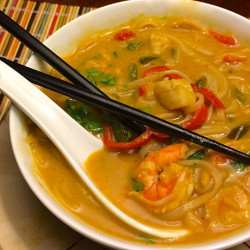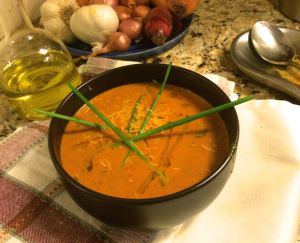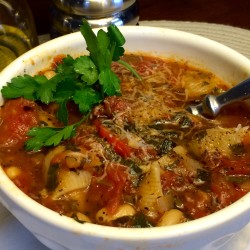Monday, September 26, 2011
Healthy and Tasty, What’s Not to Love?
My sister often exclaims “You’re always making soup!” Yup, it’s true. I really love soup, both cooking and eating it, and I make it frequently. You can search my blog and recipes page for more, but here are a few favorites:
- Sublime tomato (video)
- Roasted curried eggplant (like the one at Au Bon Pain, only better)
- Hearty vegetable (minestrone)
- Succulent crab bisque (oh, yeah, baby)
- Vietnamese noodle soup with squash, coconut, and curry (video)
- Lobster bisque (meeting the meat not required)
- Roasted cauliflower and artichoke soup (leeks, too!)
Whatever I’m cooking, I prepare a whole vat and throw some in the freezer for go-to dinners. Any time of year, I find soup to be an extremely satisfying supper when paired with a salad.
Soup—especially the way I make it—is also really, really good for you. My soups are loaded in vegetables, and remember that the more veggies you can get into your diet, the healthier you’ll be. Also, because soup has a lot of liquid, it creates volume in your stomach that helps you feel full. Paired with a fiber-rich salad, you are eating all the right things to help your body feel satiated on fewer calories. The healthiest soups are stock-based, and here’s a video showing you how to make homemade vegetable stock to get your soup started. (And more on why you should is here.) You can also buy low- or no-sodium stocks (broths) in the store. Dairy-based soups using milk or cream are obviously going to increase the calorie and saturated fat content of the soup, so I’d save those soups for special occasions. That said, as a moderate and foodie, I too adore rich soups like seafood chowder or homemade onion soup oozing with melted gruyère. We’ll get into some of those heartier recipes as the weather cools, for sure.

This minestrone soup is filled with heart-healthy and weight-friendly veggies. Click on the pic for the recipe and cooking video.
Now, if you don’t feel like making soup yourself, you can likely find some reasonable ones at the grocery store. But beware: our food supply is filled with a lot of – how shall I say it? – crap. Even so, there are a number of food companies out there that make good prepared foods, and even canned, I imagine. Remember to read the ingredient list so you know what you are eating, however, along with the other information on the nutrition facts panel that will provide details about the nutrient and calorie content. Canned foods are a major source of sodium in the diet, especially soups, so that’s another thing to check. (Aim to consume
Finally, just a little side note that I do actually consume many more things beyond soup and salad. Really. But these two meals—whether paired or on their own—are staples of what I cook and eat, and I’d encourage you to start thinking about adding more of them to your diet, whether you choose to make them yourself or buy high-quality, nutritious products elsewhere. They are good-tasting and gratifying strategies for maintaining good health and managing weight (if that’s an issue for you). Stay tuned for many more cooking ideas to bring sound nutrition science and delectable meals onto your plates and into your bowls.






I am with you on the homemade soup enthusiasm! As a pescetarian who cooks and eats vegetarian cuisine more often than not, I find that a bean-based soup is a protein-rich, flavorful, and easy entrée (not to mention that I’m almost always in the mood for soup!). I’m looking forward to making a vegetarian pasta e fagioli this week.
You mean you and I think alike, Cat? No! 😉